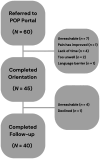Acceptability of the power over pain portal among patients awaiting tertiary care consultation: A qualitative study of patients' perceptions
- PMID: 39381808
- PMCID: PMC11459597
- DOI: 10.1177/20552076241288748
Acceptability of the power over pain portal among patients awaiting tertiary care consultation: A qualitative study of patients' perceptions
Abstract
Objective: Chronic pain affects approximately 7.6 million Canadians and access to care remains an issue. The Power Over Pain (POP) Portal offers immediate access to evidence-based resources ranging from low- (e.g. education, self-management), to high- (e.g. individual counseling) intensity. We explored the POP Portal's acceptability, usability, and perceived usefulness among patients newly referred to a tertiary care pain clinic.
Methods: We used a descriptive, qualitative approach with a prospective cohort of 60 adult patients recently referred to The Ottawa Hospital Pain Clinic. Patients were offered an orientation session and asked to participate in a seven-week follow-up interview. Data were thematically analyzed in an iterative process, whereby responses were reviewed and coded by two members of the research team.
Results: Of the 60 patients referred to the POP Portal by clinic clerks, 45 participated in the orientation session, and 40 completed a four-week follow-up. All 40 patients had used the POP Portal and recommended that we continue to offer the POP Portal to patients awaiting care. We identified overarching themes of acceptability (five subthemes), usability (ten subthemes), accessibility (three subthemes), and patient value of the POP Portal (three subthemes). This includes (1) the POP Portal provides easy access to chronic pain resources; (2) the POP Portal is helpful in developing an understanding of chronic pain; and (3) improvements to the POP Portal are needed to increase usability and foster a user-friendly experience.
Conclusions: The POP Portal offers accessible and diverse resources for people living with pain awaiting a tertiary care consultation; however, patients would like to see resources specific to diagnosis. Improvements are suggested to allow greater increase the POP Portal usability.
Keywords: Chronic pain; self-management; telemedicine.
© The Author(s) 2024.
Conflict of interest statement
The authors declared no potential conflicts of interest with respect to the research, authorship, and/or publication of this article.
Figures
Similar articles
-
Implementation-effectiveness of the power over pain portal for patients awaiting a tertiary care consultation for chronic pain: A pilot feasibility study.Digit Health. 2025 Mar 17;11:20552076251326229. doi: 10.1177/20552076251326229. eCollection 2025 Jan-Dec. Digit Health. 2025. PMID: 40103642 Free PMC article.
-
Patients' Experiences of a National Patient Portal and Its Usability: Cross-Sectional Survey Study.J Med Internet Res. 2023 Jun 30;25:e45974. doi: 10.2196/45974. J Med Internet Res. 2023. PMID: 37389909 Free PMC article.
-
Promoting and supporting self-management for adults living in the community with physical chronic illness: A systematic review of the effectiveness and meaningfulness of the patient-practitioner encounter.JBI Libr Syst Rev. 2009;7(13):492-582. doi: 10.11124/01938924-200907130-00001. JBI Libr Syst Rev. 2009. PMID: 27819974
-
Diagnosis and management of complications following pelvic organ prolapse surgery using a synthetic mesh: French national guidelines for clinical practice.Eur J Obstet Gynecol Reprod Biol. 2024 Mar;294:170-179. doi: 10.1016/j.ejogrb.2024.01.015. Epub 2024 Jan 17. Eur J Obstet Gynecol Reprod Biol. 2024. PMID: 38280271 Review.
-
Systematic review and narrative synthesis of the experiences of individuals with chronic pain participating in digital pain management interventions.PLoS One. 2024 Jul 8;19(7):e0306455. doi: 10.1371/journal.pone.0306455. eCollection 2024. PLoS One. 2024. PMID: 38976713 Free PMC article.
Cited by
-
Optimizing psychological treatments for pediatric chronic pain to enhance outcomes, availability, and accessibility.Curr Opin Psychol. 2025 Aug;64:102038. doi: 10.1016/j.copsyc.2025.102038. Epub 2025 Mar 13. Curr Opin Psychol. 2025. PMID: 40156988 Free PMC article. Review.
References
-
- Canadian Pain Task Force. Canadian pain task force report: March 2021. Ottawa, ON. 2021.
-
- Dassieu L, Choinière M, Saint-Jean L, et al. Frequency and characteristics of patient exclusion criteria in Canadian multidisciplinary pain treatment facilities: a cross-sectional study. Can J Anesth 2022; 69: 849–858. - PubMed
-
- Dear BF, Gandy M, Karin E, et al. The pain course: 12- and 24-month outcomes from a randomized controlled trial of an internet-delivered pain management program provided with different levels of clinician support. J Pain 2018; 19: 1491–1503. - PubMed
LinkOut - more resources
Full Text Sources



